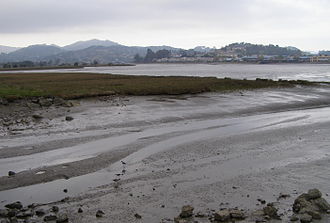
Bay mud consists of thick deposits of soft, unconsolidated silty clay, which is saturated with water; these soil layers are situated at the bottom of certain estuaries, which are normally in temperate regions that have experienced cyclical glacial cycles.
Example locations are Cape Cod Bay, Chongming Dongtan Reserve in Shanghai, China, Banc d'Arguinpreserve in Mauritania, The Bristol Channel in the United Kingdom, Mandø Island in the Wadden Sea in Denmark, Florida Bay, San Francisco Bay, Bay of Fundy, Casco Bay, Penobscot Bay, and Morro Bay.
Bay mud manifests low shear strength, high compressibility and low permeability, making it hazardous to build upon in seismically active regions like the San Francisco Bay Area. Typical bulk density of bay mud is approximately 1.3 grams per cubic centimetre.
Bay muds often have a high organic content, consisting of decayed organisms at lower depths, but may also contain living creatures when they occur at the upper soil layer and become exposed by low tides; then, they are called mudflats, an important ecological zone for shorebirds and many types of marine organisms. Great attention was not given to the incidence of deeper bay muds until the 1960s and 1970s when development encroachment on certain North American bays intensified, requiring geotechnical design of foundations.[1]
Bay mud has its own official geological abbreviation:[2] the designation for Quaternary older bay mud is Qobm and the acronym for Quaternary younger bay mud is Qybm. An alluvial layer is often found overlying the older bay mud.
In relation to shipping channels, it is often necessary to dredge bay bottoms and barge the excavated material to an alternate location. In this case, chemical analyses are usually performed on the bay mud to determine whether there are elevated levels of heavy metals, PCBs or other toxic substances known to accumulate in a benthic environment. It is not uncommon to dredge the same channel repeatedly (over a span of ten to thirty years) since further settling sediments are prone to redeposit on an open estuarine valley floor.
- ^ Farzad Naeim, The Seismic Design Handbook, Kluwer Academic Publishers, (2003) ISBN 0-7923-7301-4
- ^ Floyd Fusselman, Environmental Concerns: Learn the Acronyms, Trafford Publishing, Victoria, B.C. (2002) ISBN 1-55369-461-9